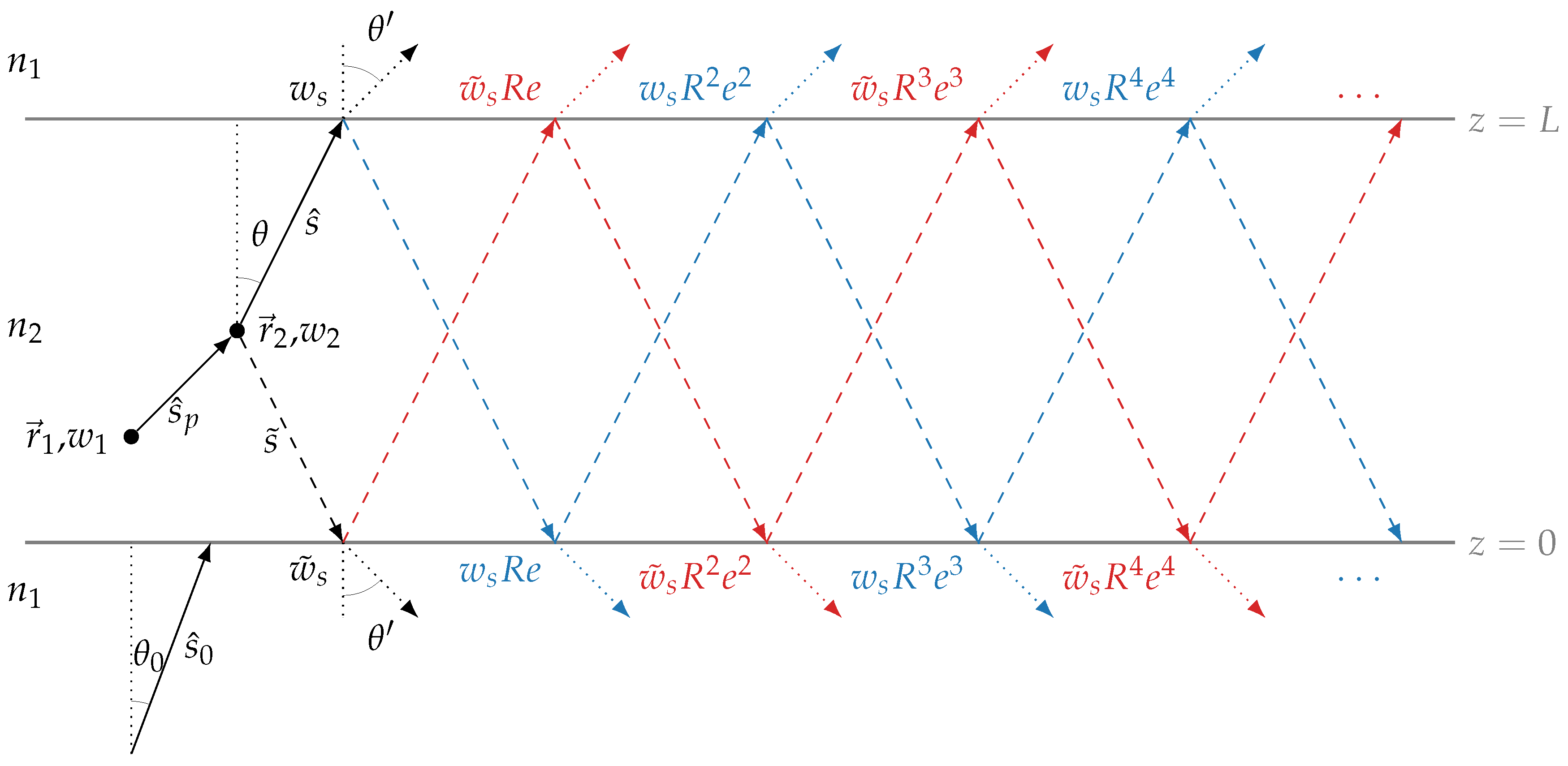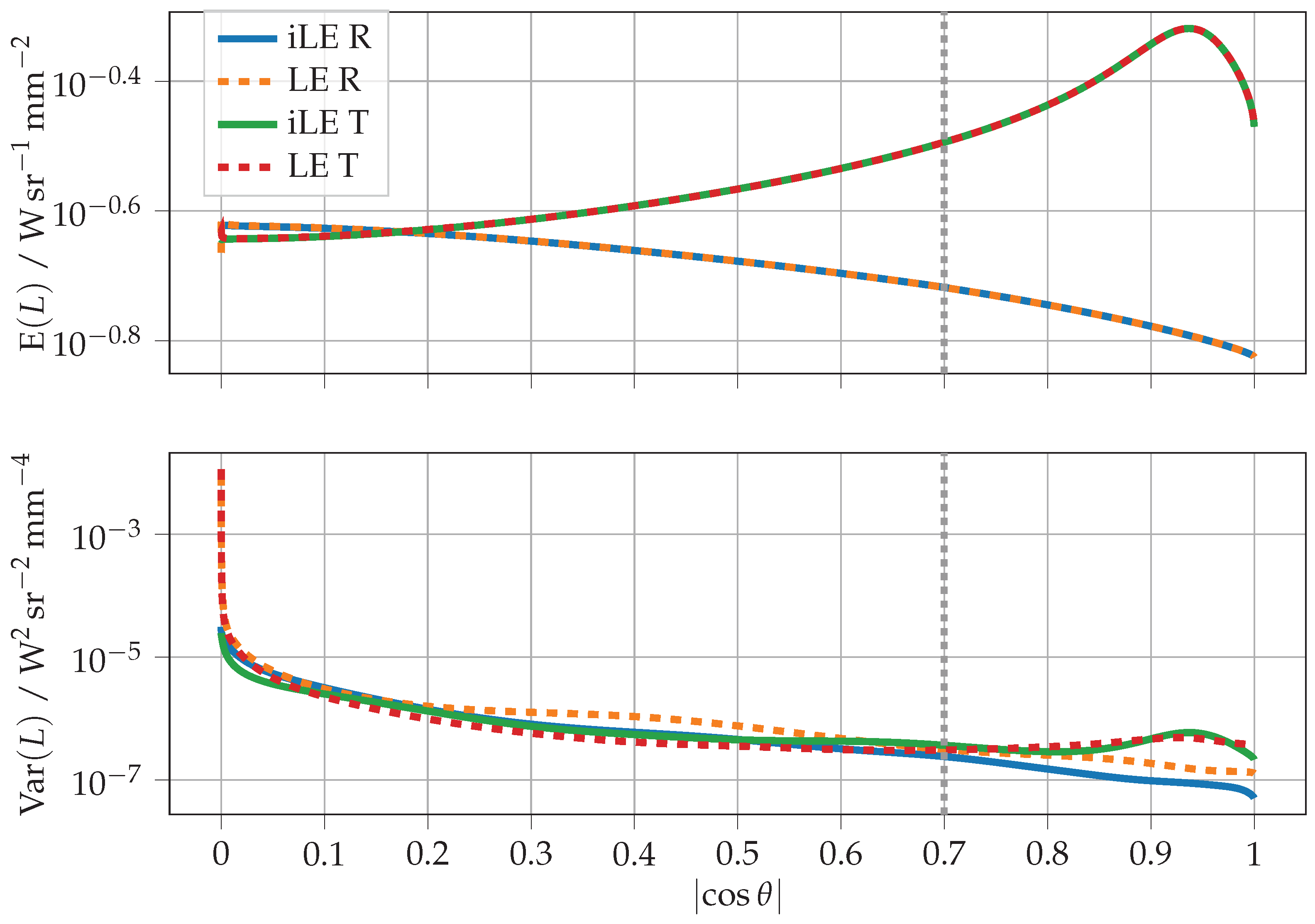An Integral-Equation-Based Variance Reduction Method for Accelerated Monte Carlo Simulations
Abstract
:1. Introduction
2. Methodology
2.1. Local Estimate Method
2.2. Integral Local Estimate Method
2.3. Monte Carlo Implementation
| Algorithm 1 Single photon propagation |
|
| Algorithm 2 Calculate radiance contributions using LE |
|
| Algorithm 3 Calculate radiance contributions using integral LE |
|
3. Results and Discussion
4. Conclusions
Author Contributions
Funding
Institutional Review Board Statement
Informed Consent Statement
Data Availability Statement
Acknowledgments
Conflicts of Interest
Appendix A. Derivation of the Integral Kernel
References
- Vincendon, M.; Langevin, Y.; Poulet, F.; Bibring, J.P.; Gondet, B. Recovery of surface reflectance spectra and evaluation of the optical depth of aerosols in the near-IR using a Monte Carlo approach: Application to the OMEGA observations of high-latitude regions of Mars. J. Geophys. Res. Planets 2007, 112, E08S13. [Google Scholar] [CrossRef]
- Barker, H.; Goldstein, R.; Stevens, D. Monte Carlo Simulation of Solar Reflectances for Cloudy Atmospheres. J. Atmos. Sci. 2003, 60, 1881–1894. [Google Scholar] [CrossRef]
- Bréon, F.M. Reflectance of Broken Cloud Fields: Simulation and Parameterization. J. Atmos. Sci. 1992, 49, 1221–1232. [Google Scholar] [CrossRef]
- McKee, T.; Cox, S. Simulated Radiance Patterns for Finite Cubic Clouds. J. Atmos. Sci. 1976, 33, 2014–2020. [Google Scholar] [CrossRef]
- Janecek, M.; Moses, W. Simulating Scintillator Light Collection Using Measured Optical Reflectance. IEEE Trans. Nucl. Sci. 2010, 57, 964–970. [Google Scholar] [CrossRef]
- Janecek, M.; Moses, W. Optical Reflectance Measurements for Commonly Used Reflectors. IEEE Trans. Nucl. Sci. 2008, 55, 2432–2437. [Google Scholar] [CrossRef]
- Trigila, C.; Moghe, E.; Roncali, E. Technical Note: Standalone application to generate custom reflectance Look-Up Table for advanced optical Monte Carlo simulation in GATE/Geant4. Med. Phys. 2021, 48, 2800–2808. [Google Scholar] [CrossRef] [PubMed]
- Barajas, O.; Ballangrud, A.; Miller, G.; Moore, R.; Tulip, J. Monte Carlo modelling of angular radiance in tissue phantoms and human prostate: PDT light dosimetry. Phys. Med. Biol. 1997, 42, 1675. [Google Scholar] [CrossRef]
- Disney, M.; Lewis, P.; North, P. Monte Carlo ray tracing in optical canopy reflectance modelling. Remote Sens. Rev. 2000, 18, 163–196. [Google Scholar] [CrossRef]
- North, P. Three-dimensional forest light interaction model using a Monte Carlo method. IEEE Trans. Geosci. Remote Sens. 1996, 34, 946–956. [Google Scholar] [CrossRef]
- Cooper, K.; Smith, J. A Monte Carlo Reflectance Model for Soil Surfaces with Three-Dimensional Structure. IEEE Trans. Geosci. Remote Sens. 1985, GE-23, 668–673. [Google Scholar] [CrossRef]
- Kurt, M.; Edwards, D. A Survey of BRDF Models for Computer Graphics. SIGGRAPH Comput. Graph. 2009, 43, 1–7. [Google Scholar] [CrossRef]
- Guarnera, D.; Guarnera, G.; Ghosh, A.; Denk, C.; Glencross, M. BRDF Representation and Acquisition. Comput. Graph. Forum 2016, 35, 625–650. [Google Scholar] [CrossRef]
- Flock, S.; Patterson, M.; Wilson, B.; Wyman, D. Monte Carlo modeling of light propagation in highly scattering tissues. I. Model predictions and comparison with diffusion theory. IEEE Trans. Biomed. Eng. 1989, 36, 1162–1168. [Google Scholar] [CrossRef]
- Wong, B.; Mengüç, M. Comparison of Monte Carlo techniques to predict the propagation of a collimated beam in participating media. Numer. Heat Transf. Part B Fundam. 2002, 42, 119–140. [Google Scholar] [CrossRef]
- Wang, L.; Jacques, S.; Zheng, L. MCML—Monte Carlo modeling of light transport in multi-layered tissues. Comput. Methods Progr. Biomed. 1995, 47, 131–146. [Google Scholar] [CrossRef]
- Pincus, R.; Evans, K. Computational Cost and Accuracy in Calculating Three-Dimensional Radiative Transfer: Results for New Implementations of Monte Carlo and SHDOM. J. Atmos. Sci. 2009, 66, 3131–3146. [Google Scholar] [CrossRef]
- Iwabuchi, H. Efficient Monte Carlo Methods for Radiative Transfer Modeling. J. Atmos. Sci. 2006, 63, 2324–2339. [Google Scholar] [CrossRef]
- Buras, R.; Mayer, B. Efficient unbiased variance reduction techniques for Monte Carlo simulations of radiative transfer in cloudy atmospheres: The solution. J. Quant. Spectrosc. Radiat. Transf. 2011, 112, 434–447. [Google Scholar] [CrossRef]
- Marchuk, G.; Mikhailov, G.; Nazareliev, M.; Darbinjan, R.; Kargin, B.; Elepov, B. The Monte Carlo Methods in Atmospheric Optics; Springer: Berlin/Heidelberg, Germany, 1980; p. 208. [Google Scholar]
- Wilson, B.; Adam, G. A Monte Carlo model for the absorption and flux distributions of light in tissue. Med. Phys. 1983, 10, 824–830. [Google Scholar] [CrossRef]
- Martelli, F.; Binzoni, T.; Bianco, S.D.; Liemert, A.; Kienle, A. Light Propagation through Biological Tissue and Other Diffusive Media: Theory, Solutions, and Validations, 2nd ed.; SPIE: Bellingham, WA, USA, 2022; p. 51. [Google Scholar]
- Machida, M. Rotated Reference Frames in Radiative Transport Theory; Progress in Optics; Elsevier: Amsterdam, The Netherlands, 2023. [Google Scholar] [CrossRef]
- Liemert, A.; Reitzle, D.; Kienle, A. Hybrid method for solving the radiative transport equation. In Proceedings of the Diffuse Optical Spectroscopy and Imaging IX, Munich, Germany, 25–29 June 2023; Contini, D., Hoshi, Y., O’Sullivan, T.D., Eds.; International Society for Optics and Photonics, SPIE: Bellingham, WA, USA, 2023; Volume 12628, p. 126281G. [Google Scholar] [CrossRef]
- Henyey, L.; Greenstein, J. Diffuse radiation in the galaxy. Astrophys. J. 1941, 93, 70–83. [Google Scholar] [CrossRef]




Disclaimer/Publisher’s Note: The statements, opinions and data contained in all publications are solely those of the individual author(s) and contributor(s) and not of MDPI and/or the editor(s). MDPI and/or the editor(s) disclaim responsibility for any injury to people or property resulting from any ideas, methods, instructions or products referred to in the content. |
© 2023 by the authors. Licensee MDPI, Basel, Switzerland. This article is an open access article distributed under the terms and conditions of the Creative Commons Attribution (CC BY) license (https://creativecommons.org/licenses/by/4.0/).
Share and Cite
Hevisov, D.; Reitzle, D.; Liemert, A.; Kienle, A. An Integral-Equation-Based Variance Reduction Method for Accelerated Monte Carlo Simulations. Photonics 2024, 11, 5. https://doi.org/10.3390/photonics11010005
Hevisov D, Reitzle D, Liemert A, Kienle A. An Integral-Equation-Based Variance Reduction Method for Accelerated Monte Carlo Simulations. Photonics. 2024; 11(1):5. https://doi.org/10.3390/photonics11010005
Chicago/Turabian StyleHevisov, David, Dominik Reitzle, André Liemert, and Alwin Kienle. 2024. "An Integral-Equation-Based Variance Reduction Method for Accelerated Monte Carlo Simulations" Photonics 11, no. 1: 5. https://doi.org/10.3390/photonics11010005
APA StyleHevisov, D., Reitzle, D., Liemert, A., & Kienle, A. (2024). An Integral-Equation-Based Variance Reduction Method for Accelerated Monte Carlo Simulations. Photonics, 11(1), 5. https://doi.org/10.3390/photonics11010005




